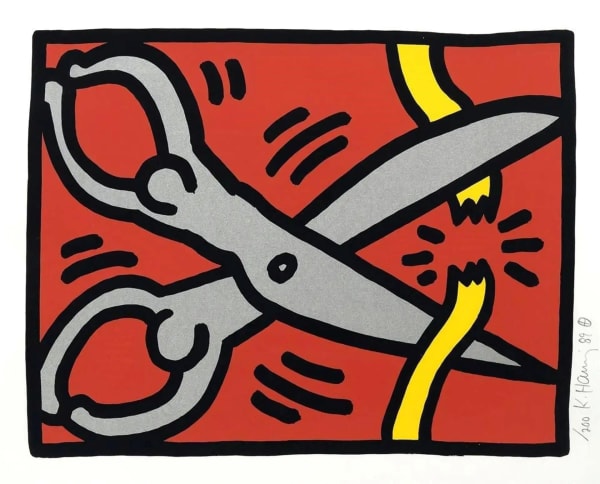Keith Haring | Popshop: Andipa, London
"Here’s the philosophy behind the Pop Shop: I wanted to continue this same sort of communication as with the subway drawings. I wanted to attract the same wide range of people, and I wanted it to be a place where, yes, not only collectors could come, but also kids from the Bronx. The main point was that we didn’t want to produce things that would cheapen the art. In other words, this was still an art statement." Keith Haring
This exhibition brings together one of Keith Haring’s most iconic series – Pop Shop. Filled with bold, fluorescent figures encased in thick, graphic black lines, Haring’s Pop Shop series is instantly recognisable. The series contains five sets of four images, each varying in colours, some pink, some red, some yellow. In Pop Shop V, the series is made unique through the addition of dancing orange, purple and pink dolphins, and a mysterious mermaid figurine. But ultimately each series is unified by the ardour of each figure within each print. As with most of his art, the figures have a playful dynamism to them; jumping, skipping, wiggling and dancing across the paper. Each print contains a highly simplified form, dancing or jumping, their movement emphasised by thick black action lines around their bodies. Haring has produced a comical and surreal series, with his figures in fantastical and impossible positions, jumping through each other, or being quite literally attached at the hip. The series is indicative of the universal pictorial language Haring has created, one radiating a childlike cheerfulness understandable to all. The flashy colours and flat pictorial plain are reminiscent of the forceful visual culture of commercial advertising that bombarded 1980’s New Yorkers. Despite the figures conveying no emotion, the prints in the Pop Shop series radiate a pure feeling of unbridled joy.
Keith Haring’s Pop Shop series is one that pays homage to the artists Manhattan ‘Pop shop’, opened from 1986 in New York City and Tokyo, as an extension of his bright, cartoonish street art. The Pop Shop prints series displayed in this exhibition reflect the most successful year of the shop, 1987-1990, where Haring was producing some of his most famous iconography. Haring committed to fulfilling his vision of making his artwork as accessible to all as possible, harking back to his humble beginnings as a graffiti artist in the subways of New York. By 1984, as Haring’s popularity grew, people began sealing his art from the subways. This made his artwork increase in value within the art market, meaning only a select few could afford his work. Pop Shop became a space to embrace a democratic ethos where is art is accessible to all, both art collectors to ‘kids from the Bronx’, breaking down the elitist barriers of the art market. Posters were sold for as little as $20, as well as T-shirts, refrigerator magnets, and even an AM-FM Radio all sold for under $25. It is fair to say Haring achieved his goal in making his art affordable for the masses. Never someone to shy away from taboos, Haring’s shop became a hub of activism, bringing awareness to contemporary social issues such as AIDS, racial inequality, and gay rights. The name ‘Pop shop’ is derived from the Pop Art movement that flourished across America during this period. It began as a defiance against the dominant narrative of what art and culture should be and look like. During the 1980s, the movement is characterised by Pop-artists turning to commercial iconography for inspiration, such as advertising, packaging, and general popular culture, revolting against traditional approaches to art. A key figure in this movement was Andy Warhol, a friend Haring was inspired by. Haring believed his Pop Shop was "keeping ideologically with what Andy was doing and what conceptual artists and earth artists were doing: It was all about participation on a big level."
For more information on any of the artworks featured and to explore our Keith Haring screen prints for sale contact Andipa Editions.

























